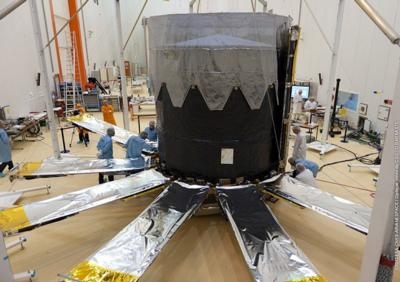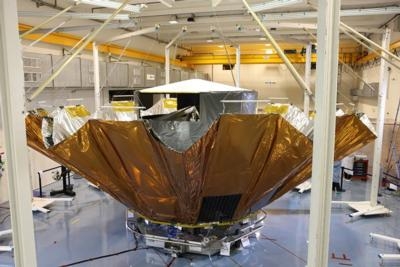Mon, Oct 14, 2013
Surveyor Will Be First Deep-Space Probe Boosted Aboard An Arianespace Soyuz Rocket
Payload preparations for Arianespace’s next Soyuz launch are progressing well at the Spaceport in French Guiana, where the Gaia billion-star surveyor is receiving its sunshield for in-orbit telescope protection as well as power generation. This sunshield is one of the final elements in completing the European Space Agency’s Gaia, the installation of which has been performed by the assembly, integration and testing team of prime contractor Astrium – with support from Spain’s SENER, which produced the sunshield.

The latest activities involved placement of the inner thermal blankets for Gaia’s multi-layer sunshield insulation, as well as incorporation of solar array panels that will provide energy to power all on-board electronics. Both elements are positioned on the sunshield’s carbon-fiber reinforced composite framework, which also was integrated at the Spaceport.
When the sunshield’s 12 folding frames are opened in orbit after launch by Arianespace’s Soyuz, the fully-insulated sunshield will form a flat disc at the base of Gaia – shading its telescope from the sun and maintaining the spacecraft’s scientific instruments at a constant temperature of approximately -100 degrees Celsius. This will allow Gaia to perform its ambitious mission of making the largest, most precise three-dimensional map of the Milky Way by surveying an unprecedented one percent of its 100 billion stars.
The solar array panels fixed to the sunshield will provide approximately 1,850 Watts of electrical power, to be used by Gaia for powering the data processing computers, along with the communications, navigation and thermal control systems. A massive amount of data will be collected over Gaia’s planned five-year mission, with its full archive to exceed 1 petabyte in size – providing enough information to answer questions related to the origin, structure and evolutionary history of the galaxy.

Gaia will be orbited on Arianespace’s Flight VS06, which is scheduled for liftoff on November 20 from the Spaceport. As indicated by the company’s launcher family numbering designation, this will be the Spaceport’s sixth liftoff with medium-lift vehicle since its introduction at French Guiana in October 2011 by Arianespace.
After being deployed by Soyuz, the hexagonal/conical-shaped spacecraft will follow a flight path to an orbit around the Sun at the second Lagrange point (L2) – a distance of about 1 million miles from Earth. This makes Gaia the first deep space payload launched by Arianespace with Soyuz from the Spaceport.
(Images provided by Arianespace)
More News
How To Get A Story On Aero-TV News/Feature Programming How do I submit a story idea or lead to Aero-TV? If you would like to submit a story idea or lead, please contact Jim Campbel>[...]
Aero Linx: International Association of Professional Gyroplane Training (IAPGT) We are an Association of people who fly, build or regulate Gyroplanes, who have a dream of a single >[...]
NORDO (No Radio) Aircraft that cannot or do not communicate by radio when radio communication is required are referred to as “NORDO.”>[...]
Beyond Visual Line Of Sight (BVLOS) The operation of a UAS beyond the visual capability of the flight crew members (i.e., remote pilot in command [RPIC], the person manipulating th>[...]
Aero Linx: Malibu M-Class Owners and Pilots Association (MMOPA) The Piper M-Class Owners & Pilots Association (PMOPA) is a not-for-profit organization dedicated to the interest>[...]
 ANN FAQ: Contributing To Aero-TV
ANN FAQ: Contributing To Aero-TV ANN's Daily Aero-Linx (05.29.24)
ANN's Daily Aero-Linx (05.29.24) ANN's Daily Aero-Term (05.29.24): NORDO (No Radio)
ANN's Daily Aero-Term (05.29.24): NORDO (No Radio) ANN's Daily Aero-Term (05.30.24): Beyond Visual Line Of Sight (BVLOS)
ANN's Daily Aero-Term (05.30.24): Beyond Visual Line Of Sight (BVLOS) ANN's Daily Aero-Linx (05.30.24)
ANN's Daily Aero-Linx (05.30.24)




